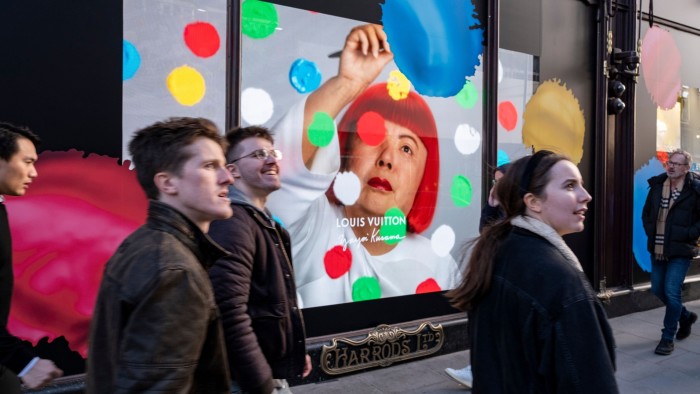Strong dollar helps US buyers boost UK jewellery sales

Roula Khalaf, Editor of the FT, selects her favourite stories in this weekly newsletter.
Last September, the US dollar peaked at 92 cents to the pound, a five-year high that brought American tourists to London during the autumn and sparked a boom in online sales of British jewellery to US buyers. London department store Harrods reported a 40 per cent increase in North American visitors between September and November compared with the same period in 2021, and those visitors were intent on luxury shopping.
“Last year was a record-breaking year for fine watches and jewellery, surpassing pre-pandemic sales, to become the category’s highest grossing year ever,” says Beth Hannaway, head of fine watches and jewellery at Harrods, with many American clients returning after a hiatus. It is a trend, she points out, that continues to gather pace now international travel is returning.
An influx of Americans with deep pockets was a boost to UK trade. Global Blue, the tax-free shopping refund agency, reported that spending by US visitors to the UK in 2022 was back at pre-pandemic levels. However, the government’s decision not to reinstate tax refunds for overseas shoppers was a huge disappointment for several UK department stores and retailers, which say they have seen luxury sales move to countries such as France.
British jewellery designers, meanwhile, noticed a big uptick in US sales on their websites, with Robinson Pelham, Diane Kordas, Cece Jewellery, NeverNoT and Jessie Thomas among the brands experiencing a surge. Robinson Pelham reported a 33 per cent increase in online sales of its rainbow gem-set jewellery compared with 2021.
“The US dollar strengthening against the pound has made fine jewellery more affordable for my American customers,” says Cece Fein Hughes, whose heirloom-style gold signet rings and pendants feature delicate miniature enamel paintings. Her bespoke orders — “capturing my customers’ dreams and making them miniature” — have been particularly popular. She says expanding in the US and launching on Net-a-Porter has brought her a wider American audience.
Similarly, London-based American jeweller Diane Kordas has seen solid growth in the US, which is proving to be a better market for her talismanic and Pop Art-style jewellery than the UK and Europe. “It is hard to know the exact driver, but it is a combination of a stronger dollar that makes sterling-priced products more competitive and the strength of the US economy relative to the other regions,” she says. Anxiety in the UK and Europe over high energy prices and the war in Ukraine has, Kordas adds, “hit [confidence] hard, and this has had an impact on sales”.
The strong dollar also provided an opportune moment for award-winning designer Fernando Jorge to take to the road and stage trunk shows at jewellery outlets in Dallas and Houston, as well as in New York’s Bergdorf Goodman department store.
One of Jorge’s stockists is Twist, which has jewellery boutiques in Portland and Seattle and a large online business. Fourteen of its 120 collections are by British designers, including NeverNoT, Alice Cicolini, Castro Smith and Ruth Tomlinson — making Twist one of US retail’s biggest supporters of British design.
Co-founder Paul Schneider says British jewellery resonates with his customers. “There is something about the history of British craftsmanship and metalworking and their natural understated approach that happens to really fit into what we at Twist are about,” he says.
Schneider, who has noticed criticism of the rising prices of some American jewellery brands, says pricing and the exchange rate are factors in Twist’s buying policy, but not the only ones. “With the value of the dollar so high and buying jewellery in pounds, [it] means we can buy a lot more,” he says, “but our priority is to deliver good value, design and craftsmanship.”
America is now the biggest market for some small British brands. Seventy per cent of Cece Jewellery’s business is in the US, and it is the largest market for NeverNoT, too. “Sales at Nordstrom, our main US retailer, have been increasing even though the exchange rate was fixed when the order was placed months ago in 2022,” says Nina Dzhokhadze, co-founder of the vibrant enamel fine jewellery brand. “Nordstrom top up their orders every quarter. We are also adding a big new stockist from May that will increase our sales, as it has new locations for us: Florida and California.”
Currencies’ shifting strengths can mean some rapid recalculating of prices. “Usually, we assess the wholesale prices for jewellery destined for the US every six months, but now we have to do it monthly because of fluctuations in exchange rates,” says Dzhokhadze.
However, the US consumer is still coming out on top. “We view anything below a 1.3 exchange rate as exceptionally favourable to the US customer and they do, too,” says Zoe Benyon, co-founder of Robinson Pelham. “We are still seeing the uptick in direct sales from US customers.”
Comments